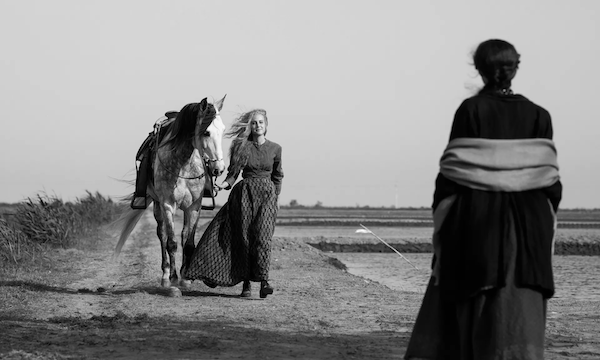In the history of affection but also just existence, lesbian identity is frequently made invisible. Sharmane Tan resets the record with a look at Isabel Coixet’s monochrome treasure Elisa y Marcela.
In Frames of War: When is Life Grievable?, Judith Butler defines the state of precarity as “a specific exploitation of targeted populations, of lives that are not quite lives, cast as destructible and ungrievable.” To this, we should ask: What does it mean to grieve a death? Grief necessitates an acknowledgement of what is lost and, in turn, it demands a recognition of what used to be present, but no longer is there. When Butler speaks of ungrievable lives, she speaks of the lives that no one mourns for, quite simply because their presence was never recognised in the first place.
Lesbians, in particular, suffer acutely from the absence of historical narratives on how we have lived, loved, and fought in a heteronormative world. To this day, many continue to marry men for safety, and most are forced to love groundlessly. Lesbian existence is precarious in the way that our lives were never present for anybody to mourn, let alone remember. Within the context, biographical lesbian period pieces are indispensable to lesbian representation for their commitment to making lesbian history visible. In recent years, Gentleman Jack, Colette, and Reaching for the Moon have established the genre of lesbian period pieces as valued by lesbian audiences, for making it clear that their lives are worthy of documentation. By filling in the gaps in lesbian history, these period pieces transformed secrecy into acknowledgment, absence into presence, shame into celebration. However, these gaps are what Isabel Coixet’s biographical adaptation Elisa y Marcela chooses to explicitly foreground. If lesbian existence is plagued with absence, then Coixet’s work self-consciously indicts itself in this precarity by persistently reminding us that history is fragile, prone to mishandling and abuse.
Coixet’s film traces the lives of two Spanish lesbians, Elisa and Marcela, from the late 19th to early 20th century. As remaining historical documents have it, Marcela passed off as a man in order to legally marry Elisa in 1901, and to seek reprieve from homophobic attacks on their relationship. Their union marked one of the first same-sex marriages in Spain that we know of today. Some rumours have also suggested that Marcela got pregnant in order for their relationship to pass for that of a straight couple. However, their disguise soon unravelled, which led to their vicious exposure by Galican and Madrid newspapers. Both women were persecuted for their love, and we know close to nothing of what happened to them after that. These were lesbians who were forced to vanish as if they never were. Coixet’s film never lets us forget how easy it is to simply make someone disappear from life altogether.
The film does this by focalising loss — specifically, parts of their lives for which there was no documentation — through the grainy, blurred lens of a 19th-century camera. This includes its ending where the two women are depicted to have built a life together. Elisa is riding on horseback, while Marcela waits for her at home. We know this scene intimately: it is the image of ideal domesticity par excellence, so embedded in most white, heterosexual narratives that some audiences may not even question whether this life is ever afforded to people from oppressed groups. On one level, the very image of two lesbians leading a life of domesticity is a joyous one, given the rarity of such represented in mainstream media. On another, as Elisa and Marcela were forced into complete secrecy in real life, the film’s focalisation of this idealised image of domesticity through grainy, blurred, static-filled lens insistently mars the beauty we see. It reminds audiences such an ending very possibly did not happen. In an earlier scene where Elisa and Marcela were enjoying themselves by the beach, Elisa questions: “This is real isn’t it? It isn’t a dream?”
From the perspective of an audience who knows of the reduced lives they were condemned to lead, everything seen in this film is, of course, a dream. And the women only speak of dreams in this scene: Elisa dreams of riding on horses, and she dreams of Marcela too. She dreams precisely of the two things the film offers in its denouement. Images of an imagined freedom are matched with an expansive backdrop of sea and sand, which contrasts the actual oppression these women will face in time to come. It becomes clear that this biographical film offers an alternatively imagined ending — or, perhaps, future — for women whose lives were only worth the societal effort of persecution and not celebration. The static-filled lens which stymies the beauty in the film, then, testifies to the difficulty of even envisioning an ordinary, perfectly domestic future for lesbians. By honing in on the very necessity of imagination for ordinary instances like these, Elisa y Marcela highlights that an average, mundane life most take for granted, is a hard-won one for others. When you have to fight for the ordinary, the ordinary is precisely what you can lose.
After all, fiction is what the film is, isn’t it? While Elisa y Marcela makes a conscious effort to render lesbian lives visible, it is no less naive to the difficulties of recovering history — especially the history of oppressed groups whose lives were deemed as forfeit, much less worthy of documentation. However, in the context where lesbian joy is rarely represented in media, it is worth questioning if audiences ought to see an optimistic ending filtered through the fragmented, incomplete dint of lesbian history. Lesbian existence is already precarious, do lesbian viewers really need to be reminded just how difficult it is to rewrite their history as well? My answer is a resounding yes — if lesbian joy continues to be hard won, it is only right that the instrinsic difficulty of lesbian survival is made apparent for the world to see. The difference of lesbian love is that it signifies that an erotic autonomy between women is possible in a thoroughly patriarchal world, even if that possibility is diminished with every act of homophobia. By highlighting the difficulty of recovering lesbian history and survival, Elisa y Marcela realises just how miraculous it is that we can even see lesbian joy — whether those lives are real or imaginary.
Sharmane (@jenvoievaiser) is a freelance film journalist based in Singapore. She's currently assistant editor for Much Ado About Cinema, and has written for sites like Into The Fold Magazine, Screen Queens, and Flip Screen.
READ ME is a platform for female-led writing on film commissioned by Girls on Tops. Louisa Maycock (@louisamaycock) is Commissioning Editor and Ella Kemp (@ella_kemp) is Contributing Editor.




